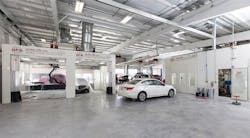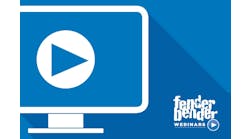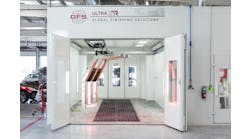Shop Process Improvements Guaranteed to Increase Throughput
By Jason Garfoot, technical adviser/training manager, Global Finishing Solutions
Collision shops today are continually striving to improve processes and increase throughput. These two things are directly related; however, many shops focus all their attention on increasing throughput without making the necessary changes to improve their processes. Shops may see small gains by having their employees work harder or longer hours but this does not last long. It is nearly impossible to increase throughput in a sustainable way without implementing more efficient processes. In many cases, improving shop processes can lead to huge gains in throughput without having to hire additional staff or purchase expensive equipment.
Identifying Bottlenecks
The first step to improving your shop processes is to identify which areas need work. It’s important to keep an open mind. Involve your employees, as they will have a good idea of what slows them down and prevents them from reaching their full potential.
When you think you have identified a bottleneck, look at the process leading up to it. It is easy to falsely identify a bottleneck. I have worked with many shops that think the paint booth is their primary bottleneck. When we dig deeper, we may find that the real problem is the rate and order at which vehicles are prepped or the way vehicles are scheduled to come into the shop.
Also, look at the processes immediately after your bottleneck. You may fix one problem, only to end up creating another. Consider the paint booth example again. If you double the amount of work going through the paint booth, the reassembly and detail areas may now become overwhelmed and unable to keep up.
Teardown, Estimating and Scheduling
During the estimating phase, vehicles must be torn down completely in order to obtain an accurate estimate. If you don’t fully tear down a vehicle, you will miss things and drastically hinder throughput. For example, if a vehicle is in the repair process and you discover you need to order a part, the entire job can come to a halt. To learn how to properly teardown a vehicle and write an accurate repair order, I encourage you to hire a consultant or have your estimators take a course.
Effective scheduling is another smart way to improve throughput. Many shops still schedule cars to come in on a Monday and go out on a Friday. This schedule puts stress on certain departments at different points throughout the week, causing huge swings in throughput. The body men are overwhelmed during the first part of the week. Then the paint department gets slammed with work midweek. Since several vehicles are ready for paint at the same time, the booth becomes congested and vehicles could sit untouched for days. As vehicles leave the paint department in groups, the body men are now forced to reassemble multiple vehicles at once. This schedule negatively affects efficiency and can lead to easily avoidable mistakes which could lower your CSI score. For better efficiency, accuracy, throughput and employee morale, your weekly schedule should be well balanced with cars coming in and going out every day of the week.
Priming Practices
Shops can produce a better-quality repair and increase throughput by applying the appropriate amount of primer to vehicles throughout the day, as opposed to batch priming. With batch priming, shops wait until the end of the day to prime all of the vehicles at once. Technicians tend to apply too much primer so they don’t have to reprime the next day if they burn through it when sanding. When primer is overapplied, it dries on the outside but traps solvents underneath. Over the next few weeks, the primer will continue to dry and shrink until the repair area becomes visible through the paint job. Known as edge mapping, this results in a poor-quality repair, potentially costly rework and decreased customer satisfaction.
Maximizing your Paint Booth
To maximize the efficiency of your paint booth, shops should be averaging 12 paint hours in each booth cycle, with a minimum of four to five booth cycles in an eight-hour period. That’s a minimum of 48 paint hours per booth per day. This is easily obtainable by making a few minor process changes.
First, paint parts off the vehicle. ‘Cutting in’ or ‘jamming’ parts and bolting them on the car for painting is incredibly inefficient. In the time it takes to do this, the entire part could have been painted. Paint technology has come a long way and it is no longer necessary to paint parts on the car to achieve a quality match. Every paint company offers tinting and color matching classes to train painters.
For example, say there are two cars to be painted. Car 1 is getting a new hood and bumper, and we are blending both fenders for 11 hours of paint time. Car 2 is getting a new fender, and we are blending the door for five hours of booth time. If these are painted in two separate booth cycles, each car will need to be masked once it is in the booth. The average paint hours per booth cycle would be 8 (11+5 divided by 2 cycles). If we were to remove the fenders from Car 1 and the door from Car 2, both these jobs will now fit in the booth at the same time. Since the bodies of the cars do not go into the booth, we save valuable masking time and materials. We now achieved a booth cycle with 16 paint hours. Even if it takes two actual hours to remove and install the fenders and door, we have doubled our average paint hours per cycle and eliminated an entire booth cycle.
Floor mapping is another way to get the most out of your booth. Start by measuring the sprayable area of your paint booth. This is the area in the booth where items can be painted without sacrificing quality. Typically, this is about 2 feet in from each wall. So, if your booth is 27 feet long and 14 feet wide, your sprayable area is most likely about 23 feet long by 10 feet wide. Once you’ve determined the sprayable area, tape off or paint an area this size outside of the booth. Then, load this area with the parts you are painting next. By mapping it out before you get into the booth, you may find you can squeeze in a few more parts, increasing the efficiency of your next booth cycle.
One shop that implemented this strategy increased their booth output by an average of 17.9 hours per day the first week. That’s nearly an additional 90 paint hours per week. If they were charging $50 an hour they would be getting an extra $4,500 a week. If they were only averaging 40 percent profit on those paint hours they would be adding $93,000 profit directly to their bottom line every year!
Improving Technology
In addition to process improvements, shops can increase throughput by implementing new technology. Improvements in technology — such as software, equipment and paint — have led to improvements in paint finish quality, shop efficiency and cycle time. There are several computerized management systems on the market that can be easily integrated into your current software. New clear coat products provide excellent quality while cutting bake time in half.
Equipment technology has taken major leaps in the last few years. Paint booths are much more efficient than they used to be. Paint booth spray zones are also increasing, allowing painters to get more out of each booth cycle and paint multiple colors without getting overspray on other parts.
Accelerated curing systems can have a major impact on paint shop throughput. Forced air systems can dry waterborne basecoat in about half the time. Shortwave electric infrared systems can be implemented into all phases of the repair process to significantly reduce curing times for filler and coatings. Primer that used to take hours to dry can now be cured in a matter of minutes, while also improving quality. Booth cycle times can be reduced to less than 30 minutes with electric IR systems. I have seen shops double their throughput with this new technology.
Regardless of your shop size or profitability, I encourage you to take a look at your current processes to see if there are ways you can improve them. Even minor improvements can have a major impact on your bottom line.



